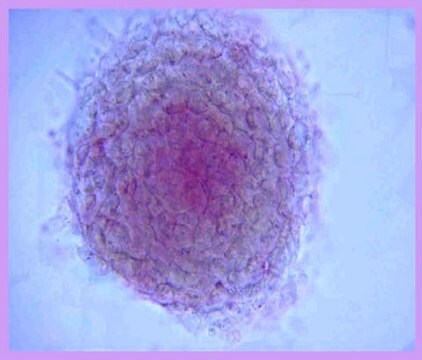AP0100
Alkaline Phosphatase Diethanolamine Activity Kit
sufficient for 100 tests
Sinónimos:
ALP Activity Kit
Iniciar sesiónpara Ver la Fijación de precios por contrato y de la organización
About This Item
Código UNSPSC:
12352202
NACRES:
NA.26
Productos recomendados
uso
sufficient for 100 tests
temp. de almacenamiento
2-8°C
Descripción general
The Alkaline Phosphatase Diethanolamine Detection Kit provides ready-to-use reagents for detecting the presence of alkaline phosphatase activity. This simple assay to detect alkaline phosphatase activity uses p-Nitrophenyl Phosphate (pNPP) as the substrate.
Aplicación
Alkaline Phosphatase Diethanolamine Activity Kit has been used:
- in the detection of alkaline phosphatase (ALP) levels in the blood serum and osteoblasts
- for monitoring ALP levels during osteoblast differentiation in mouse myoblast C2C12 cells
- for determining ALP activity in the bone metastasis model of lung cancer
- for measuring ALP levels in colon tissue homogenates
Idoneidad
Suitable for the measurement of alkaline phosphatase activity in a variety of samples
Principio
Alkaline phosphatase hydrolyzes pNPP to p-nitrophenol and inorganic phosphate. During incubation of the alkaline phosphatase sample and substrate at 37 C, the reaction is followed by monitoring the increase in absorbance at 405 nm.
Los componentes del kit también están disponibles por separado
Referencia del producto
Descripción
SDS
Palabra de señalización
Danger
Frases de peligro
Consejos de prudencia
Clasificaciones de peligro
Eye Dam. 1 - Repr. 2 - Skin Irrit. 2 - STOT RE 2 Oral
Órganos de actuación
Kidney,Liver,Blood
Código de clase de almacenamiento
10 - Combustible liquids
Clase de riesgo para el agua (WGK)
WGK 3
Punto de inflamabilidad (°F)
Not applicable
Punto de inflamabilidad (°C)
Not applicable
Elija entre una de las versiones más recientes:
Certificados de análisis (COA)
Lot/Batch Number
¿No ve la versión correcta?
Si necesita una versión concreta, puede buscar un certificado específico por el número de lote.
¿Ya tiene este producto?
Encuentre la documentación para los productos que ha comprado recientemente en la Biblioteca de documentos.
Los clientes también vieron
XiaoQing Lu et al.
Medical science monitor : international medical journal of experimental and clinical research, 25, 9524-9530 (2019-12-14)
BACKGROUND Angiopoietin-like proteins (ANGPTL) are a family of secretory glycoproteins that are involved in many pathophysiological processes. ANGPTL7 is a newly-discovered member of the ANGPTL family and plays a role in corneal morphogenesis, angiogenesis, glaucoma, and cancer. To date, whether
11beta-hydroxysteroid dehydrogenases as targets in the treatment of steroid-associated femoral head necrosis using antler extract
Pu R and Peng H
Experimental and Therapeutic Medicine, 15(1), 977-984 (2018)
Tumor targeting with docosahexaenoic acid-conjugated docetaxel for inhibiting lung cancer metastasis to bone
Jiang S, et al.
Oncology Letters, 16(3), 2911-2920 (2018)
Triptolide inhibits the function of TNF-alpha in osteoblast differentiation by inhibiting the NF-kappaB signaling pathway
Liu SP, et al.
Experimental and Therapeutic Medicine, 14(3), 2235-2240 (2017)
Jianming Chen et al.
International journal of molecular medicine, 43(3), 1513-1521 (2019-01-11)
MicroRNAs (miRNAs) have emerged as pivotal regulators in various physiological and pathological processes at the post‑transcriptional level, and may serve important roles in osteogenic differentiation. However, their roles and functions are not fully understood. In the present study, miR‑223‑5p was
Nuestro equipo de científicos tiene experiencia en todas las áreas de investigación: Ciencias de la vida, Ciencia de los materiales, Síntesis química, Cromatografía, Analítica y muchas otras.
Póngase en contacto con el Servicio técnico








